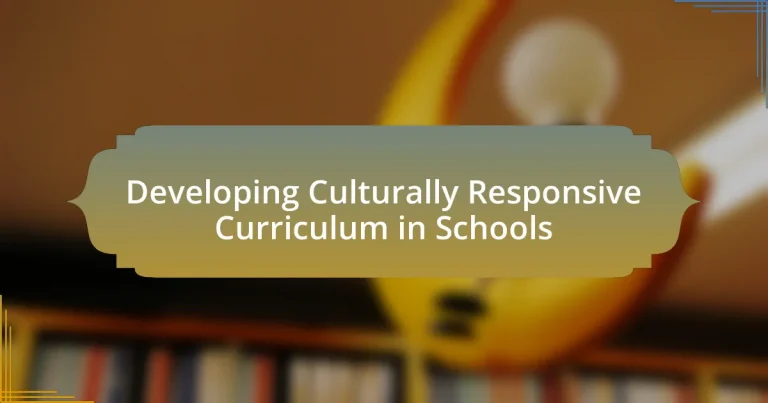Developing a culturally responsive curriculum in schools involves creating educational programs that acknowledge and incorporate the diverse cultural backgrounds of students, enhancing engagement and academic achievement. This approach fosters an inclusive learning environment, promoting equity and addressing the needs of all learners. Key principles include recognizing cultural identities, integrating diverse perspectives, and encouraging critical thinking about social justice. Challenges such as resource limitations and resistance to change can hinder implementation, but strategies like community partnerships and teacher training can support effective curriculum development. Overall, a culturally responsive curriculum is essential for improving educational outcomes and fostering a sense of belonging among students from various backgrounds.

What is Developing Culturally Responsive Curriculum in Schools?
Developing a culturally responsive curriculum in schools involves creating educational programs that recognize, respect, and incorporate the diverse cultural backgrounds of students. This approach aims to enhance student engagement and achievement by making learning relevant to their cultural experiences. Research indicates that culturally responsive teaching can lead to improved academic outcomes, as it fosters a sense of belonging and validation among students from various backgrounds. For instance, a study by Gay (2010) highlights that culturally responsive pedagogy not only improves student performance but also promotes equity in education by addressing the needs of all learners.
Why is a culturally responsive curriculum important in education?
A culturally responsive curriculum is important in education because it enhances student engagement and academic achievement by recognizing and valuing diverse cultural backgrounds. This approach fosters an inclusive learning environment where students feel respected and understood, which can lead to improved motivation and participation. Research indicates that culturally relevant pedagogy can significantly boost the performance of students from marginalized communities, as it connects learning to their cultural experiences and identities. For instance, a study by Ladson-Billings (1994) demonstrated that students who engaged with culturally relevant materials showed higher levels of academic success and self-esteem. Thus, implementing a culturally responsive curriculum is essential for promoting equity and improving educational outcomes for all students.
How does cultural responsiveness impact student engagement?
Cultural responsiveness significantly enhances student engagement by fostering an inclusive learning environment that acknowledges and values diverse cultural backgrounds. When educators implement culturally responsive teaching practices, they create relevance in the curriculum, which resonates with students’ identities and experiences. Research indicates that students who see their cultures reflected in the classroom are more likely to participate actively and feel a sense of belonging. For instance, a study by Gay (2010) in “Culturally Responsive Teaching: Theory, Research, and Practice” demonstrates that culturally responsive pedagogy leads to increased motivation and academic success among students from diverse backgrounds. This connection between cultural relevance and student engagement underscores the importance of integrating cultural responsiveness into educational practices.
What role does cultural identity play in learning?
Cultural identity significantly influences learning by shaping students’ perspectives, motivations, and engagement in educational settings. When students see their cultural backgrounds reflected in the curriculum, they are more likely to feel valued and understood, which enhances their learning experience. Research indicates that culturally responsive teaching practices, which acknowledge and incorporate students’ cultural identities, lead to improved academic outcomes and increased student participation. For instance, a study by Gay (2010) in “Culturally Responsive Teaching: Theory, Research, and Practice” demonstrates that students perform better academically when their cultural contexts are integrated into the learning process. This evidence underscores the critical role cultural identity plays in fostering an inclusive and effective learning environment.
What are the key principles of a culturally responsive curriculum?
The key principles of a culturally responsive curriculum include recognizing and valuing students’ cultural backgrounds, integrating diverse perspectives into the curriculum, fostering an inclusive learning environment, and promoting critical thinking about social justice issues. Recognizing and valuing students’ cultural backgrounds ensures that their identities are acknowledged and respected, which enhances engagement and learning outcomes. Integrating diverse perspectives allows for a richer educational experience, as it reflects the varied histories and contributions of different cultures. Fostering an inclusive learning environment encourages collaboration and respect among students from different backgrounds, which is essential for a harmonious classroom atmosphere. Promoting critical thinking about social justice issues equips students with the skills to analyze and challenge inequities in society, preparing them to be informed and active citizens. These principles are supported by research indicating that culturally responsive teaching improves academic performance and social-emotional development among diverse student populations.
How can educators incorporate diverse perspectives into the curriculum?
Educators can incorporate diverse perspectives into the curriculum by integrating multicultural content and diverse authors into lesson plans. This approach ensures that students are exposed to a variety of viewpoints and experiences, fostering an inclusive learning environment. Research indicates that curricula reflecting diverse perspectives enhance student engagement and academic achievement, as seen in studies like “Culturally Responsive Teaching: Theory, Research, and Practice” by Geneva Gay, which highlights the positive impact of culturally relevant pedagogy on student outcomes. By actively including materials that represent different cultures, histories, and viewpoints, educators can create a more equitable and enriching educational experience.
What strategies promote inclusivity in lesson planning?
Strategies that promote inclusivity in lesson planning include differentiating instruction, incorporating diverse perspectives, and utilizing collaborative learning. Differentiating instruction allows educators to tailor lessons to meet the varied needs of students, ensuring that all learners can engage with the material effectively. Incorporating diverse perspectives involves integrating content that reflects the backgrounds and experiences of all students, which fosters a sense of belonging and relevance. Collaborative learning encourages students to work together, promoting social interaction and mutual respect among peers from different backgrounds. Research indicates that these strategies enhance student engagement and achievement, as evidenced by studies showing improved academic outcomes in inclusive classrooms.
What challenges do schools face in developing a culturally responsive curriculum?
Schools face several challenges in developing a culturally responsive curriculum, including a lack of resources, insufficient teacher training, and resistance to change. Limited funding often restricts access to diverse materials and professional development opportunities, hindering the implementation of inclusive practices. Additionally, many educators may not receive adequate training on cultural competence, which is essential for effectively integrating diverse perspectives into the curriculum. Resistance from stakeholders, including parents and community members, can also pose significant barriers, as differing views on cultural representation may lead to conflicts. These challenges collectively impede the ability of schools to create an educational environment that reflects and respects the diverse backgrounds of all students.
How can resistance to change be addressed in educational settings?
Resistance to change in educational settings can be addressed by fostering open communication and involving stakeholders in the decision-making process. Engaging teachers, students, and parents in discussions about the benefits of change can help alleviate fears and misconceptions. Research indicates that when educators are included in the planning and implementation phases, they are more likely to support new initiatives, as seen in a study by Fullan (2007), which emphasizes the importance of collaboration and shared vision in successful educational reforms. Additionally, providing professional development opportunities tailored to the needs of educators can equip them with the skills and confidence necessary to embrace change, further reducing resistance.
What resources are available to support curriculum development?
Resources available to support curriculum development include educational frameworks, professional development programs, and digital tools. Educational frameworks, such as the Universal Design for Learning (UDL) and culturally relevant pedagogy, provide guidelines for creating inclusive curricula that address diverse student needs. Professional development programs, offered by organizations like the National Education Association, equip educators with strategies to implement culturally responsive teaching practices. Digital tools, including curriculum mapping software and online resource libraries, facilitate the organization and accessibility of educational materials. These resources collectively enhance the effectiveness of curriculum development by ensuring it is responsive to the cultural contexts of students.
How can schools assess the effectiveness of their culturally responsive curriculum?
Schools can assess the effectiveness of their culturally responsive curriculum by utilizing student performance data, feedback from students and parents, and classroom observations. Analyzing standardized test scores and grades can reveal whether students from diverse backgrounds are achieving academic success, indicating the curriculum’s relevance and inclusivity. Additionally, conducting surveys and focus groups with students and parents can provide insights into their perceptions of the curriculum’s cultural relevance and engagement. Classroom observations can help educators evaluate the implementation of culturally responsive teaching practices and their impact on student participation and learning outcomes. Research indicates that schools employing these assessment methods can better understand the curriculum’s effectiveness in meeting the needs of all students, thereby fostering an inclusive educational environment.
What are the best practices for implementing a culturally responsive curriculum?
The best practices for implementing a culturally responsive curriculum include integrating diverse cultural perspectives, fostering an inclusive classroom environment, and utilizing culturally relevant teaching materials. Integrating diverse cultural perspectives ensures that students see their identities reflected in the curriculum, which enhances engagement and learning outcomes. Fostering an inclusive classroom environment involves creating a safe space where all students feel valued and respected, promoting open dialogue about cultural differences. Utilizing culturally relevant teaching materials, such as literature and resources that represent various cultures, supports students’ connections to the content and encourages critical thinking about cultural issues. Research indicates that culturally responsive teaching can lead to improved academic performance and social-emotional development among students from diverse backgrounds.
How can teacher training enhance cultural responsiveness in the classroom?
Teacher training can enhance cultural responsiveness in the classroom by equipping educators with the knowledge and skills to recognize and address diverse cultural backgrounds. This training often includes strategies for integrating culturally relevant pedagogy, which fosters an inclusive learning environment that respects and values students’ cultural identities. Research indicates that culturally responsive teaching improves student engagement and academic performance, as evidenced by a study published in the “Journal of Teacher Education,” which found that teachers who received training in cultural competence were more effective in meeting the needs of diverse student populations.
What role do community partnerships play in curriculum development?
Community partnerships play a crucial role in curriculum development by providing diverse perspectives and resources that enhance educational relevance and cultural responsiveness. These partnerships enable schools to integrate local knowledge, cultural practices, and community needs into the curriculum, ensuring that it reflects the backgrounds and experiences of all students. For instance, research indicates that schools collaborating with local organizations can improve student engagement and achievement by aligning educational content with community values and real-world applications. This collaborative approach fosters a more inclusive learning environment, ultimately leading to better educational outcomes for students from various cultural backgrounds.
What practical steps can educators take to create a culturally responsive curriculum?
Educators can create a culturally responsive curriculum by incorporating diverse perspectives and materials that reflect the backgrounds of all students. This involves selecting texts, resources, and examples that represent various cultures, histories, and experiences, ensuring that students see themselves in the curriculum. Additionally, educators should engage in professional development focused on cultural competence to better understand their students’ cultural contexts. Research indicates that culturally relevant pedagogy enhances student engagement and academic success, as demonstrated in the work of Gloria Ladson-Billings, who emphasizes the importance of connecting learning to students’ cultural experiences.


